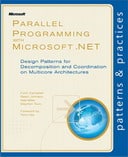
Free ebook “Parallel Programming with Microsoft .NET: Design Patterns for Decomposition and Coordination on Multicore Architectures” from Microsoft in pdf format.
Book Description
This book describes patterns for parallel programming, with code examples, that use the new parallel programming support in the Microsoft .NET Framework 4.
The CPU meter shows the problem. One core is running at 100 percent, but all the other cores are idle. Your application is CPU-bound, but you are using only a fraction of the computing power of your multicore system. What next?
The answer, in a nutshell, is parallel programming. Where you once would have written the kind of sequential code that is familiar to all programmers, you now find that this no longer meets your performance goals. To use your system’s CPU resources efficiently, you need to split your application into pieces that can run at the same time.
This is easier said than done. Parallel programming has a reputation for being the domain of experts and a minefield of subtle, hard-to-reproduce software defects. Everyone seems to have a favorite story about a parallel program that did not behave as expected because of a mysterious bug.
These stories should inspire a healthy respect for the difficulty of the problems you face in writing your own parallel programs. Fortunately, help has arrived. The Microsoft® .NET Framework 4 introduces a new programming model for parallelism that significantly simplifies the job. Behind the scenes are supporting libraries with sophisticated algorithms that dynamically distribute computations on multicore architectures. In addition, Microsoft Visual Studio® 2010 development system includes debugging and analysis tools to support the new parallel programming model.
Proven design patterns are another source of help. This guide introduces you to the most important and frequently used patterns of parallel programming and gives executable code samples for them, using the Task Parallel Library (TPL) and Parallel LINQ (PLINQ). When thinking about where to begin, a good place to start is to review the patterns in this book. See if your problem has any attributes that match the six patterns presented in the following chapters. If it does, delve more deeply into the relevant pattern or patterns and study the sample code.
Table of Contents
- Introduction
- Parallel Loops
- Parallel Tasks
- Parallel Aggregation
- Futures
- Dynamic Task Parallelism
- Pipelines
- Adapting Object-Oriented Patterns
- Debugging and Profiling Parallel Applications
- Technology Overview
Download Free PDF / Read Online
Format(s): PDF, HTML
Number of pages: 224
Link: Download or read online.